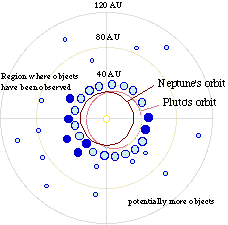What are Cepheid variables?

Cepheid variable stars are the name for a special type of
variable star first discovered in the constellation Cepheus. A
variable star's brightness changes over time. In the case of
Cepheids, imagine your lungs expanding and contracting as you breathe.
Cepheid variable stars "breathe" in the sense that they, too, are
expanding and contracting, and this causes their brightness to change
in a very regular (astronomers say "periodic") way.
Cepheids are extremely important to astronomers because their
periodic changes in brightness can be used to figure out how far away
they are. Because Cepheids are intrinsically bright stars, they can
be seen far away, and astronomers can use them to determine the
distance to very distant galaxies.
Submitted by Henrik Berg (Norway)
(February 10, 1998)
You might also be interested in:

Cepheus was king of a land called Ethiopia in Greek myth. He had a wife named Cassiopeia and a daughter, Andromeda. Cassiopeia liked to brag about her beauty so much, that she said she and Andromeda were
...more
It depends on which type of motion you are asking about. If you take a birds-eye view from the top of the solar system all the planets orbit around the Sun in a counter-clockwise (or direct) direction.
...more
Almost everyone has a question or two about living in space. What do astronauts do in space? How do they do everyday things like eat, sleep and go to the bathroom? It's important to note that astronauts
...more
There is a really neat internet program called Solar System Live that shows the position of all of the planets and the Sun for any given day. If you go to that page, you'll see an image similar to the
...more
The picture of the American Flag (the one put there by the Apollo astronauts) is waving (or straight out) in the wind. How could that be possible if there is no atmosphere on the Moon? Was it some sort
...more
I was wondering if there is a new planet? Are there planets (a tenth planet?) after Pluto belonging to our solar system? What are the names of the new planets discovered in the solar system? Are there
...more
If that is so, the energy released during the Big Bang must have created many such black holes. Therefore most of the Energy of the Big bang must have disappeared in that form. Then how did the Universe
...more














